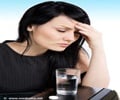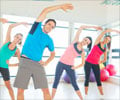- Some people develop headaches during or immediately after strenuous exercise and it is called exercise induced headache.
- The causes for the headache could be due to certain foods consumed, dehydration, poor neck position and improper breathing technique.
- Prevention is associated with adopting healthier exercise pattern.
The International Classification of Headache Disorders
The definition of primary exercise headache as provided by The International Classification of Headache Disorders is that form of headache which is caused by any form of exercise and which does not occur due to any intracranial disorder.- Diagnostic Criteria: When two or more headaches occur after or when exercises are carried out and which last longer than 48 hours. These headaches should not be due an underlying neurologic problem.
- Primary exercise headaches include
- exertional headache
- primary cough headache
- headache linked to sexual activity.
Reasons Behind Exertion Headache
Exertion headache occurs during a combination of the following situations- Bad Position of the Neck: A position other than the neutral spine position results in a constriction of the carotid arteries.
- Excess Weight: The more amount of additional weight, the higher the blood pressure would increase.
- Practice of Holding the Breath: Holding the breath can lead to a spike in blood pressure.
- Lack of Sufficient Water: Dehydration can result in the thickening of blood.
- Increase in Heart Rate: Exercise increases the heart rate with every set, resulting in increase above maximal heart rate.
Phases in Exertional Headaches
Exertion induced headaches pass through 3 phases:- Intense Headache Phase: This is the first phase which is severe and painful, occurring during or soon after a workout. The headache is felt at the back of the head or in the temples with searing pain which is rapid. The headache remains even after the workout till there is a decrease in heart rate.
- Dull Headache Phase: The next phase is dull and lasts up to 2 weeks. This type of headache is felt in the areas where the initial intense headache was felt.
- Recovery Phase: Complete recovery from the headache depends on how severe the initial headache was and the extent of rest that was provided to the body.
Preventing Exertional Headaches
Though exercise is beneficial to the body, people who experience exertional headaches should stop or lower the intensity of their exercise. It is very important for athletes to find out the various mechanisms of prevention.- Food intake varies with each individual and certain foods like cured meat, beans, nuts, fruits or cheese could cause headache.
- Eating small, well-balanced meals spaced throughout the day for three to six times along with drinking plenty of water could be helpful in lowering primary exercise headache.
- Adequate sleep is another important preventive measure. People should sleep for at least 8 hours. Sleep disruptions like an uncomfortable sleep environment, excess noise and lights should be avoided.
Following a good warm up schedule will aid in preventing exercise mediated headaches according to a study by scientist Varkey and colleagues. They examined the effect of an exercise program among migraine patients to increase oxygen uptake without making the migraine worse. In this study, the participants were asked to carry out a 15minutes warm up before they carried out 45 minutes of intense physical activity. The findings of the study show that
- The migraine did not become worse even though the exercise was intense.
- People to develop a tolerance towards headaches induced by strenuous exercise
- Lowered the monthly number of migraines
- Magnesium: Studies have shown that magnesium could lower exercise induced headaches.
- Low levels of magnesium or Hypomagnesemia in the cerebrospinal fluid are associated with exercise-induced headaches.
- Nearly 30% of people with migraines have reduced magnesium levels.
- Daily supplementation with 400mg of magnesium was found to reduce the frequency of headaches.
- Riboflavin and CoQ10: Riboflavin and ubiquinone affect mitochondrial energy. When these are present in low amounts, it could affect the mitochondrial energy production and lead to the development of migraines.
- Feverfew: Feverfew aids in reduction in aggregation of platelets along with the prevention of serotonin release. A daily supplementation of 300 mg reduces the frequency of migraines.
References:
- Exertion Headaches - (http://www.apexllc.org/articles/exertion-headaches/)
















